Placental protein 13 (PP13/galectin-13) undergoes lipid raft-associated subcellular redistribution in the syncytiotrophoblast in preterm preeclampsia and HELLP syndrome
- PMID: 21596368
- PMCID: PMC3527099
- DOI: 10.1016/j.ajog.2011.03.023
Placental protein 13 (PP13/galectin-13) undergoes lipid raft-associated subcellular redistribution in the syncytiotrophoblast in preterm preeclampsia and HELLP syndrome
Abstract
Objective: To investigate placental protein 13 (PP13) localization in relation to cytoskeleton and lipid rafts in preeclampsia and HELLP syndrome.
Study design: Placental cryosections from patients with preeclampsia and HELLP, and controls were stained for PP13, actin, PLAP (lipid raft marker), and CD71 (nonraft marker). BeWo cells exposed to stress conditions were stained for PP13 and actin. Protein localizations were investigated by confocal microscopy, PP13 concentrations by ELISA.
Results: PP13-actin colocalization was increased in syncytiotrophoblast juxtamembrane regions in term/preterm preeclampsia and HELLP. PP13-CD71 colocalization was decreased and PP13-PLAP proximity was increased in preterm but not term preeclampsia and HELLP. PP13-release from BeWo cells was inhibited by cytoskeleton disruption, and augmented by Ca2+-influx and ischemic stress.
Conclusion: The actin cytoskeleton, probably in connection with lipid rafts, controls trophoblastic "nonclassical" PP13 export. PP13 is released from the syncytiotrophoblast in preterm preeclampsia and HELLP, mimicked in BeWo cells by ischemic stress, suggesting PP13 is a placental alarmin.
Copyright © 2011 Mosby, Inc. All rights reserved.
Figures
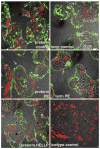
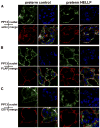

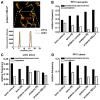

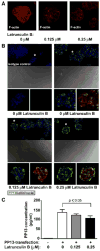
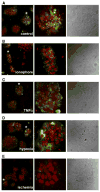
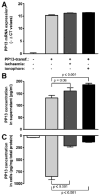
References
-
- Di Renzo GC. The great obstetrical syndromes. J Matern Fetal Neonatal Med. 2009;22:633–5. - PubMed
-
- Romero R. Prenatal medicine: the child is the father of the man. J Matern Fetal Neonatal Med. 2009;22:636–9. - PubMed
-
- Roberts JM, Lain KY. Recent Insights into the pathogenesis of pre-eclampsia. Placenta. 2002;23:359–72. - PubMed
-
- Redman CW, Sargent IL. Latest advances in understanding preeclampsia. Science. 2005;308:1592–4. - PubMed
-
- Sibai B, Dekker G, Kupferminc M. Pre-eclampsia. Lancet. 2005;365:785–99. - PubMed
Publication types
MeSH terms
Substances
Grants and funding
LinkOut - more resources
Full Text Sources
Other Literature Sources
Medical
Miscellaneous

